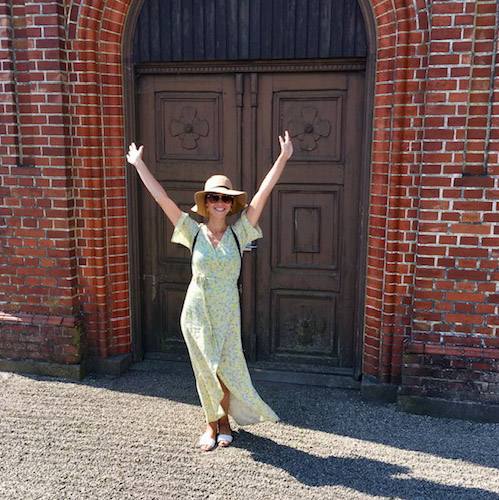Tackling a Rare Brain Tumor With Expertise and Skill

Diagnosed with a brain tumor, Marrissa Janssen was scared. Her biggest fear was that doctors wouldn’t be able to get rid of the entire mass. But after consulting with experts at Mayo Clinic, Marrissa’s fear turned to hope. Now, after surgery and proton beam therapy, the tumor is gone.
Sept.
6, 2018, started off as a typical day for 33-year-old attorney Marrissa
Janssen. She was on a conference call at work, trying to share some facts and
figures. “I wanted to say a number, but couldn’t get the words out,”
Marrissa says.” It lasted about 10 or 15 seconds.”
Shortly
after, she experienced tingling and numbness in her arms and legs. Although her
symptoms only lasted a short time, she was concerned. She texted her husband. Suspecting
a stroke, she went to a local emergency department in Sioux Falls, South Dakota.
Scans showed that Marrissa had an unusual mass in her brain. The hospital recommended she go to Mayo Clinic’s Rochester campus for further evaluation.
A team of experts
Five days later, Marrissa and her husband made the four-hour drive from Sioux Falls to Mayo Clinic to meet with neurosurgeon Giuseppe Lanzino, M.D. After reviewing the scans, Dr. Lanzino asked colleague Terence Burns, M.D., Ph.D. for his opinion.
“The
tumor was surrounding a branch of the middle cerebral artery,” Dr. Burns
says. “It was located within the part of Marrissa’s brain that allowed her
to speak. Removing tumors from this area is most safely achieved via awake brain
surgery — a procedure some of my colleagues and I do on a regular basis.”
Awake brain surgery is the safest and most effective strategy for removing tumors from parts of the brain where various important functions are located. During the mapping portions of the surgery, sedation is suspended, so the patient can be fully awake and participate in neurological and cognitive testing.
By
electrically stimulating and briefly inactivating sensitive brain areas affected
by a tumor, the surgeon can determine whether a tumor can safely be removed
without compromising function. Depending on the region of the brain that’s involved,
those functions can include coordination, sensation, language and higher-level cognitive
processes, such as problem-solving.
“Dr.
Burns was confidently soft in the way he delivered the news,” Marrissa
says.
“He
said it was a small tumor with clear margins, or areas where it started and
stopped. He said that after he removed it, he would take a slice of the mass and
send it to pathology to determine if it was cancerous.”
“Dr. Burns was extraordinary. And Mayo, it’s this majestic unicorn. When you’re there, it feels as though this whole team is in place just for you.”
Marrissa Janssen
Marrissa’s
surgery took place the following day. During the procedure, Dr. Burns found
that the tumor appeared quite different than the surrounding brain tissue, with
no obvious evidence of infiltration. Based on its appearance during surgery, Dr.
Burns hoped the tumor would be a pleomorphic xanthoastrocytoma, or PXA, because
complete removal of these tumors typically bodes well for long-term survival.
PXA is an extremely rare type of brain tumor that occurs in less than 1 in 1
million individuals — typically in children and young adults.
A
complicating factor in the surgery was that the section of Marrissa’s brain
responsible for language came up to the edge of the tumor, making complete
removal challenging.
“We
had to accept that if there were any infiltrating cells even slightly beyond
the visible edge of the tumor, we would not be able to safely chase after them,”
Dr. Burns says. “Marrissa and I had agreed prior to surgery that our top
priority was to keep her safe — maintaining her language function and thereby preserving
her quality of life. By the end of surgery, I felt all visibly suspicious areas
for tumor had been removed, and her language function remained intact.”
An unusual finding
When the pathology results returned, they did include certain genetic features of a PXA, as Dr. Burns had hoped. However, the genetics of Marrissa’s tumor showed something more unusual and concerning. Her tumor harbored additional alterations not seen in PXA, but characteristic of glioblastoma — a far more aggressive type of tumor. What it meant to have mixed features intermediate between PXA and glioblastoma was uncertain.
Mayo
Clinic has been actively pioneering the field of glioma genetics. According to Dr.
Burns, the vast majority of people with gliomas have no family history. In most
cases, the genetic changes arise spontaneously, allowing a tumor to develop.

“Identifying
these genetic alterations can help establish a diagnosis and provide insights
regarding response to therapy. However, there are occasional tumors, like Marrissa’s,
that simply defy known classifications,” Dr. Burns says. “It can be quite
a challenge to predict how these will behave, and it requires the wisdom of the
multidisciplinary team to tailor optimal treatment recommendations.”
An excellent result
After surgery, Marrissa met with neuro-oncologists Joon Uhm, M.D., Michael Ruff, M.D., and Ivan Carabenciov, M.D., to craft a treatment plan going forward.
“They were very calm and comforting. They gave me hope, in the sense that my age and overall health were on my side, and that the tumor was missing a lot of markers for an aggressive epithelioid glioblastoma,” Marrissa says. “They indicated that radiation would be part of the care plan and referred me to Paul Brown, M.D., for proton beam therapy.”
Marrissa
began daily proton beam therapy treatments on Oct. 15, 2018, and completed her
last treatment on Dec. 5. “It wasn’t painful, but there was fatigue and some
hair loss, which were anticipated side effects,” she says.
Marrissa’s
follow-up scans in January and April brought good news, with no evidence of any
recurrence of the tumor.
“Dr.
Burns was extraordinary,” Marrissa says. “And Mayo, it’s this
majestic unicorn. When you’re there, it feels as though this whole team is in
place just for you.”
“We may not be able to fully appreciate everything our patients and families are going through at these most vulnerable moments in their lives. But it is a privilege to be there for them and with them as an extended family.”
Terence Burns, M.D., Ph.D.
“In
January, Marissa and her husband sent one of the most beautiful and eloquent
letters I have ever read,” Dr. Burns says. “It reflected on the fear
and sadness in being so abruptly reminded that life is so fragile, yet also on
gratitude for life’s joy and richness, and the gift of time to share memories
with family and friends. We may not be able to fully appreciate everything our
patients and families are going through at these most vulnerable moments in
their lives. But it is a privilege to be there for them and with them as an
extended family.”
Now
Marrissa is savoring life as it comes. She’s returned to work part time while
she continues to fully regain her strength. She also recently traveled to the
New Orleans Jazz & Heritage Festival for the first time with her husband.
“I’m
grateful that no matter what may come, we were given more time to spend
together,” Marrissa says. “I’m thankful that the care team gave us
hope and that my life was worth trying to save.”
HELPFUL LINKS
- Read about Mayo Clinic’s Brain Tumor Program.
- Learn more about the Proton Beam Therapy Program at Mayo Clinic.
- Connect with others talking about living with a brain tumor on Mayo Clinic Connect.
- Explore Mayo Clinic’s Rochester campus.
- Request an appointment.
